85 KMS North of Beirut, has a special character all its own.
Thanks to its historical wealth, relaxed lifestyle and thriving
business climate, this is a city where modern and medieval blend
easily into a lively and hospitable metropolis. Known as the
capital of the North, Tripoli is Lebanon’s second largest city.
The city flourished under the Arabs and many of its principal
monuments go back to Islamic times, such as famous Bourj as Siba,
a tower built by the Mamluks in the 15th C. There are also many
beautiful Mosques, Madrassa, Khan, Souk and Bazaar. Towering above
the Abou Ali River stands the Fortress of Saint Gilles " SINIJIL",
built by Raymond de St. Gilles on Mt. Pelerin in the early 12th C.
and which was since remade and enlarged by the Mamluks and Turks.
 |
tripoli 
BAALBEK 85 KMS East-Northeast of Beirut, is the embodiment
of the superlative. It is one of the worlds ’s greatest
historical sites the most gigantic complexof Roman temples ever
built, its columns are the tallestever erected, and its stones the
largest ever used. The acropolis encompasses the temples of
BACCHUS, VENUS & JUPITER. At a short distance lie the ruins of an
Umayyad mosque vestiges of Arab ramparts can be seen in the town.
For a number of years Baalbeck floodlit mercurial columns presided
over the annual renowned international festival which featured
Theatre groups,orchestras, ballet troupes and performers from all
parts of the world. Baalbeck is an important administrative and
economic centre in the northern Beqaa valley.
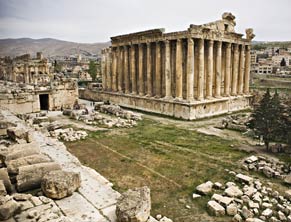
tyre 83 KMS South of Beirut, Phoenician Tyre was queen of the seas, an island city of unprecedented splendour. She grew wealthy from her far – reaching colonies and her industries of purple – dyed textiles. But she also attracted the attention of jealous conquerors, among them the Babylonian King Nebuchadnezzar and Alexander the Great. Founded at the start of the third millenniB.C. , Tyre originally consisted of a mainland settlement and a modest island city that lay a short distance off shore. But it was not until the first millennium B.C. That the city experienced its golden age.

saida 48KMS South of Beirut, the capital of the s, is one of the famous names in ancient history. But of all of Lebanon’s cities this is the most mysterious, for its past has been tragically scattered and plundered. In the 19th century , treasure hunters and amateur archaeologists made off with many of its most beautiful and important objects, some of which can now be seen in foreign museums. Sidon’s Phoenicians Period began in the 12th-10th century B.C. and reached its height during the Persian Empire ( 550–330 B.C. ) . The city provides Persia, a great land power, with the sips and seamen to fight the Egyptians and Greeks, a role that gave it a highly favoured position. The Persimaintained a royal park in Sidon and it was during this time that the temple of Eshmoun was built.

beirut The capital of the Lebanese Republic, has long been considered, by virtue of its strategic location, the crossroads between the three continents of Asia, Africa and Europe, and the gateway to the East .Its three million inhabitants are unique blend of Eastern and western cultures. Beirut survived a decade and a half of conflict " the City that would not die" . As if to demonstrate this resiliency, the Lebanese have launched a great rush of building activity, including the public service infrastructure. In the ruined City Centre, a huge reconstruction project is underway to create a new commercial and residential district for the 21st century.

BYBLOS "Jbeil"
37 KMS North of Beirut. Byblos is one of the top contenders for the " oldest continuously inhabited city" award. According to Phoenician tradition the God "El" Founded it, and even the Phoenicians considered it a city of great antiquity. Although its beginnings are lost in time, modern scholars say the site of Byblos goes back at least 7,000 years.
The four main places of interest to visit in Byblos are the Castle, built by the Crusaders in the 12th and 13th centuries, the Egyptian temples, the earliest of which dates back to the 4th Millennium, the Phoenician Royal necropolis where king Ahiram’s sarcophagus, which bears one of the oldest alphabetic inscriptions yet discovered anywhere in the world, was found, and the Roman amphitheatre.
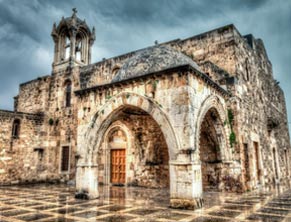
the cedars
120 KMS Beirut, known to the Lebanese as Arz ar-Rab "The Cedars of the Lord", some of the remaining 400 Trees are over 1500 Years old. It is believed that some of them even date back to the time when King Solomon had a part of the forest cut down to build his temple in Jerusalem. Just below the Cedars is the town of Becharre, birthplace of Gibran Khalil Gibran .The village of the Cedars, over 2000 meters in altitude, is a very picturesque ski resort with hotels, chalets and ski lifts. Nearby is the Qadisha grotto, a natural cavern with Stalactite and Stalagmite formations.
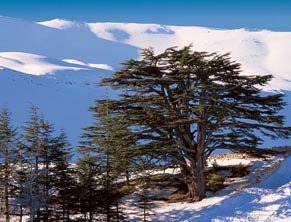
BEIT-EDDINE 40 KMS Southeast of Beirut, the road to Beit-Eddine leaves the coastal highway 17 KMS beyond Beirut The most spectacular view of the village of Deir el Qamar (Monastery of the Moon), five kms before Beit-eddine. The Beit-ddine palace complex Lebanon’s best example of early 19th century Lebanese architecture, was built over a thirty year period by Emir Bechir el Chehab II, who ruled Mount – Lebanon for more than half a century. Today Beit-eddine , with its museums and its garden, is one of Lebanon’s major tourist attractions .
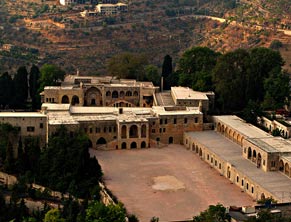
anjar 58 KMS east of Beirut, is completely different from
any other archaeological experience you’ll have in Lebanon. At
other historical sites in the country, different epochs and
civilisations are superimposed one on top of the other. Anjar is
exclusively one period, the Umayyad . Lebanon’s other sites were
Founded millennia ago, but Anjar is a relative new comer, going
back to the early 8th century A.D.
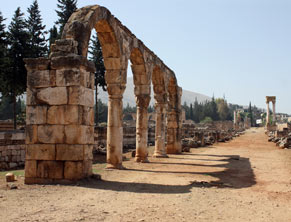
nahr el kalb On the way to Jounieh, one passes by
" Nahr el–Kalb " famous for its commemorative inscriptions Ramses
II. " 1290 – 1224 B.C " Asarhadon" 680 – 669 B.C " Nebuchadnezzar
" 605 –562B." Marcus Aurelius, Caracalla and the Sultan Seif
eddin Barquq, all have left steles behind to record their
victories, and modern inscriptions commemorate the two World Wars
and later the evacuation of foreign troops from Lebanon in " 1946
".

JOUNIEH 18 KMS North of Beirut, formerly a sunny lazy town
of fine old houses with red tile roofs and surrounding greenery,
has developed into city with high rise buildings and luxurious
shopping and entertainment centres. Its outstanding feature is its
magnificent wide day, a perfect curve of lucid blue from which
Mount Lebanon seems to rise in a smooth and graceful sweep.
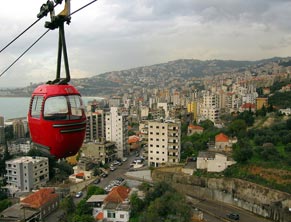
bekaa valley Is the Northern tip of the Great Rift Valley, which
passes southward and across the Sea into the African Continent.
Lebanon’s Major River, the Litany, feeds this vast plateau,
Lebanonâ’s largest agricultural area. It also in this plain that
Lebanon’s wine industry, fast becoming recognised on the
international market, is located. The Phoenicians epics found in
the Royal Library of Ugarit described the land of Beqa’a as a
place for gods as early as 1400 B.C. Less than 50 KMS from Beirut
is the town of Chtaura, famed for its healthy dry climate. Nearby
Zahle, known as " Arouses al Beqa’a" the bride of the Beqa’a, with
its green hills and golden vineyards, is located on the banks of
Bardawni River, and is famous for riverside al fresco restaurants.
Zahle styles itself " The City of Wine and Poetry" and with
good reason. In this century alone some 50 poets and writers were
born here and almost as many excellent wines and arks have been
produced in the area.

ECHMOUN The Temple of Echmoun , less than an hour from
Beirut, is situated one KMS from Sidon in a lush valley of citrus
groves on the Awwali River .This Phoenician temple complex
dedicated to the healing god Echmoun , is the only Phoenician site
in Lebanon that has retained more than its foundation stones .
Building was begun at the end of the 7th century B.C. and later
additions were made in the following centuries. Thus many elements
near the original temple site were completed long after the
Phoenician era , including the Roman period colonnade, mosaics a
nymphaeum , and the foundation of a Byzantine church . All of
these buildings testify to the site’s lasting importance.
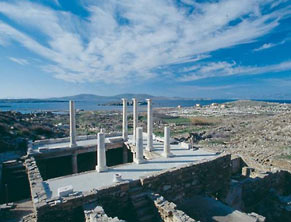
MOUNT LEBANON Beit-Mery, Brummana, Ba’abdat, Dhour ash-Shwayr, Faytroon, Rayfoon and Ajaltoon, all share a beautiful climate with a stunning view of either the Mediterranean or of pine–covered Mountains and valleys. They have excellent tourist and a very active nightlife. Mount Lebanon is also home of the Jeita grottoes, an awesome honeycomb of natural galleries and ravines hung with breathtaking stalactites and stalagmites; of Faqra, Afqa and its sacred grottoes, and of our Lady of Harissa overlooking Jounieh Bay.

|
